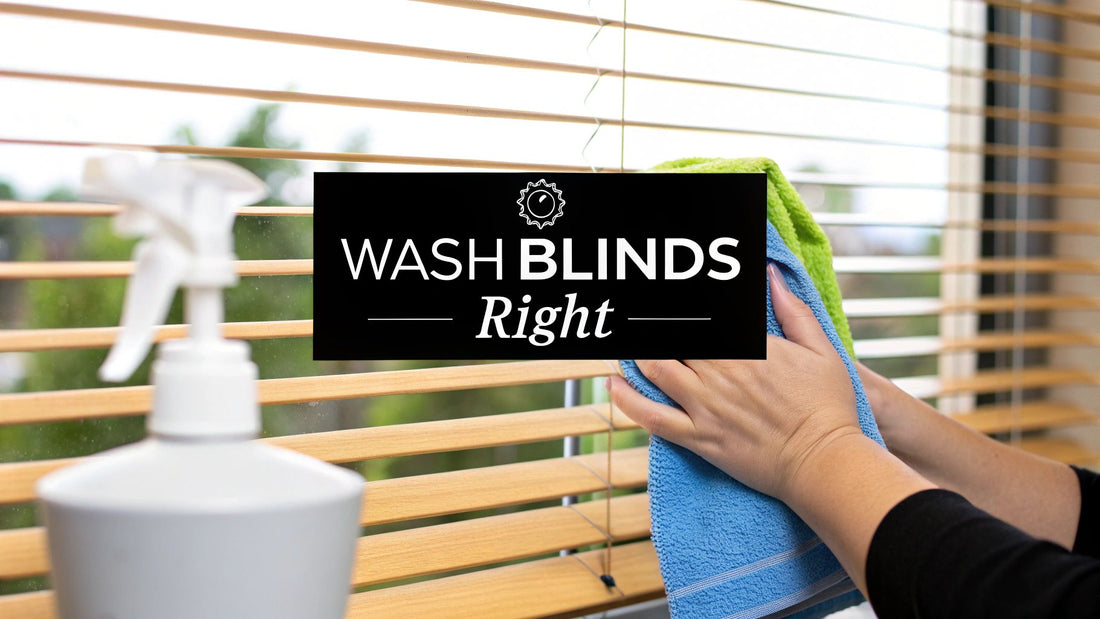Not all blinds are created equal, and how you wash them depends entirely on what they're made of. You wouldn't throw a wool sweater in a hot wash, and the same logic applies here. A one-size-fits-all approach can quickly lead to warped wood, stained fabrics, or damaged slats.
For durable types like vinyl or aluminum, a simple wipe-down with soapy water often does the trick. But if you're dealing with fabric blinds, you’ll want to stick to gentle vacuuming to avoid water spots or shrinkage. And real wood? Keep it dry. Water is the enemy of wood blinds and can cause irreversible damage.
The goal is to clean effectively without causing harm. It all starts with identifying your blind material.
Your Quick Guide to Washing Different Blinds
The secret to clean blinds isn't a marathon cleaning session once a year; it's consistent, light maintenance. A little bit of regular upkeep prevents the heavy buildup of dust and grime that turns a small chore into a huge project.
Staying on top of it not only keeps your blinds looking fresh but also significantly extends their lifespan. For more on this, check out our detailed guide on how to eliminate dust in your home to keep those pesky allergens from settling in.
Cleaning at a Glance
This handy visual guide breaks down everything you need to know about blind maintenance, from how often to clean them to the tools you'll need for the job.
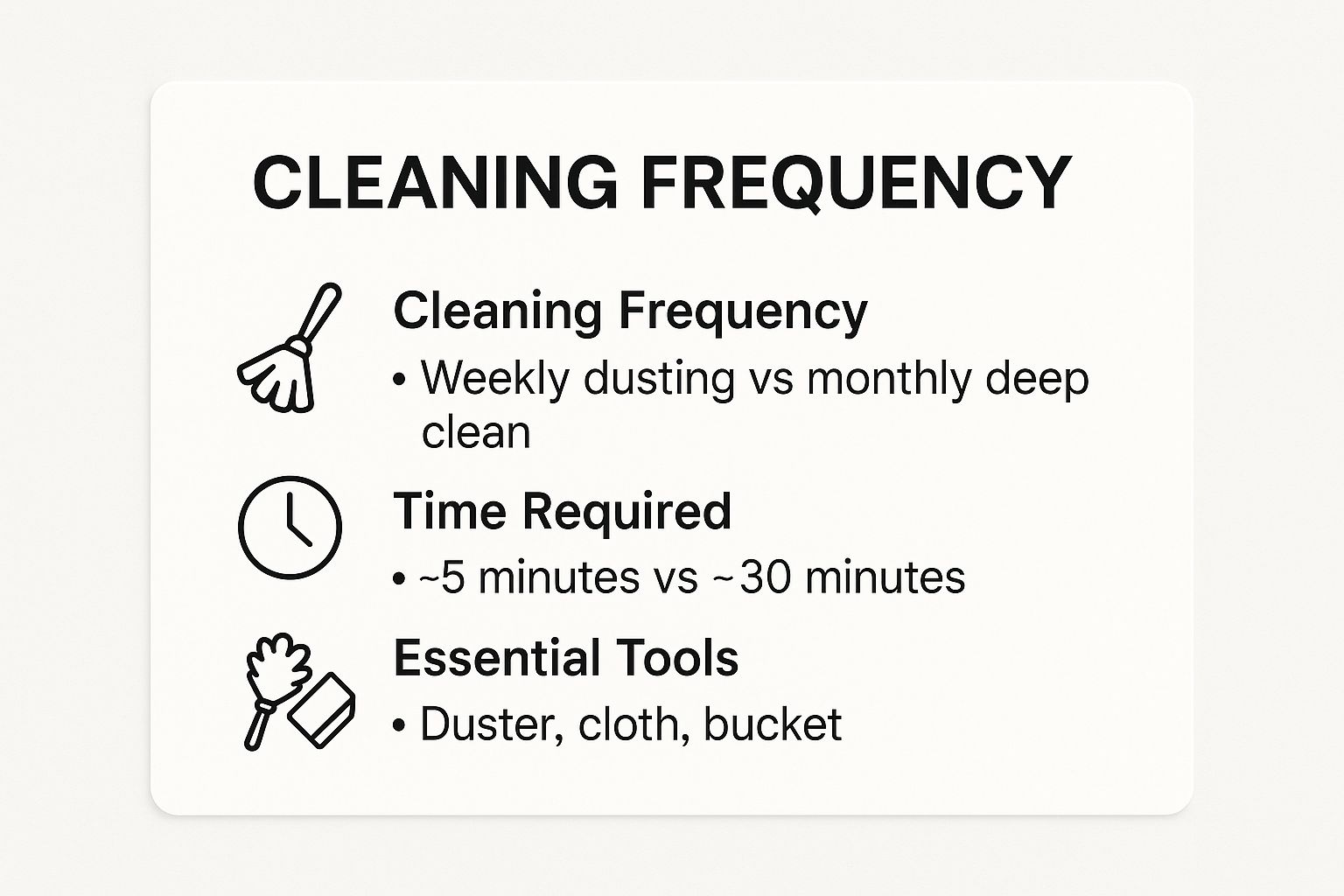
As you can see, a quick five-minute dusting session each week is usually all it takes. That saves the deeper, 30-minute clean for a monthly or seasonal task when things need a bit more attention.
People are definitely paying more attention to home hygiene these days, and that includes professional blind cleaning. The U.S. blind cleaning market was valued at a whopping USD 1.2 billion in 2024 and is expected to more than double by 2033. This surge shows a big shift toward creating cleaner, healthier indoor spaces.
The real secret to spotless blinds isn't the occasional deep scrub—it's the small, consistent efforts. Just a few minutes of dusting each week stops stubborn grime from ever taking hold, making the whole process worlds easier.
For a quick reference, I've put together this simple table summarizing the best approaches for common blind materials.
Blind Cleaning Methods at a Glance
| Blind Material | Best Cleaning Method | Water Usage | Key Precaution |
|---|---|---|---|
| Vinyl/Aluminum | Wipe with damp cloth & mild soap | Minimal | Dry thoroughly to prevent water spots. |
| Fabric | Vacuum with brush attachment | None | Avoid water, as it can cause staining or shrinking. |
| Real Wood | Dust with a microfiber cloth | None | Never use water; it can warp or discolor the wood. |
| Faux Wood | Wipe with a damp cloth | Minimal | More durable than real wood, but still dry slats after cleaning. |
This table should give you a good starting point. Always test a small, inconspicuous area first if you're unsure how your blinds will react to a cleaning solution.
Assembling Your Blind Cleaning Toolkit
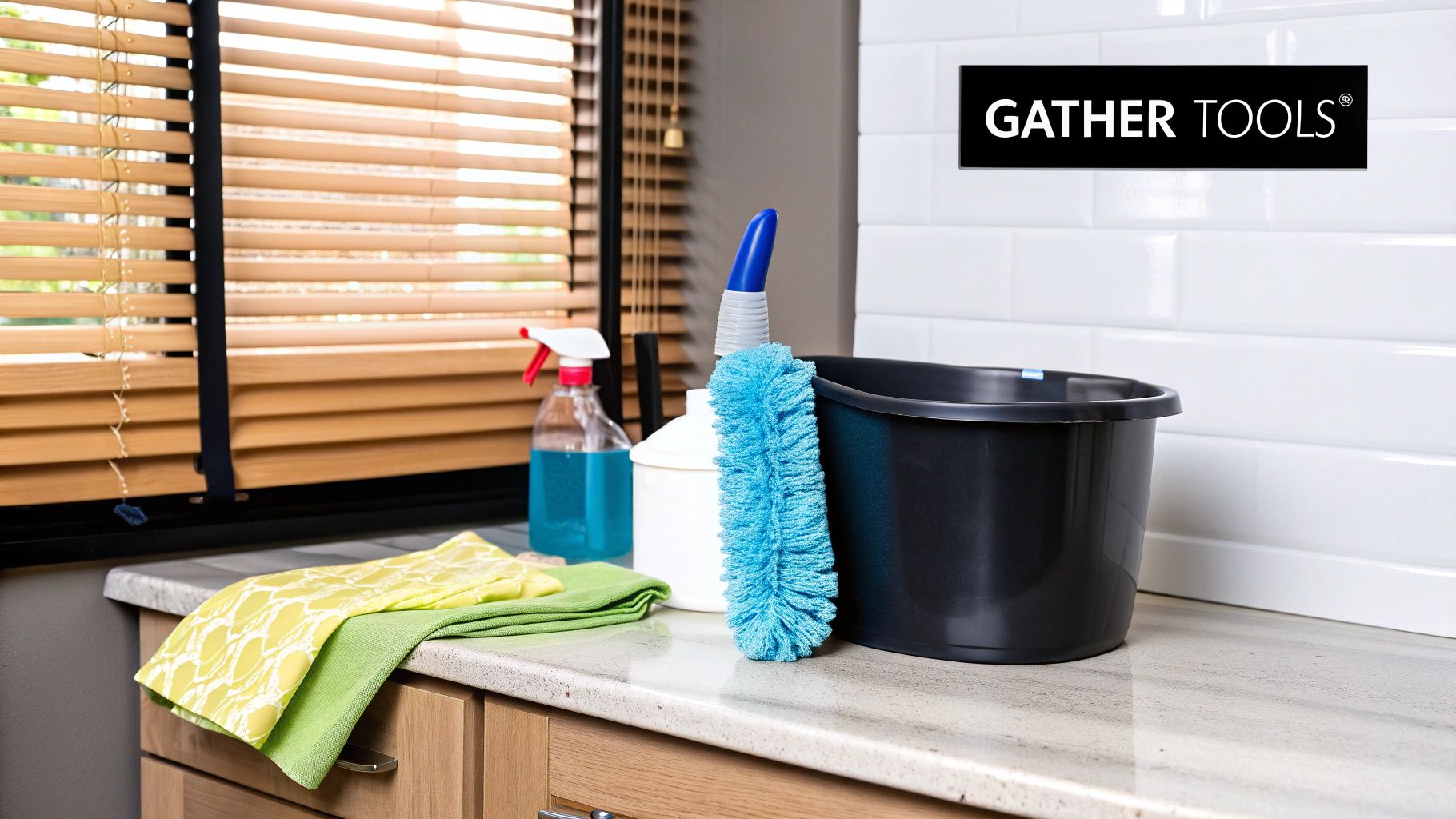
Having the right tools on hand can turn blind cleaning from a dreaded chore into a quick, satisfying task. Before you even touch a slat, gathering your supplies will save you from that frustrating mid-clean scramble for a cloth or bucket. Think of it like prepping your ingredients before cooking—it just makes everything go smoother.
Chances are, you already have most of what you need right at home. By getting your toolkit organized first, you’ll be ready to tackle anything from a light layer of dust to stubborn, built-up grime.
Essentials for Light Dusting
For the weekly upkeep that keeps dust from getting out of hand, you only need a couple of simple items. This quick pass is your best defense against allergens and that fuzzy buildup that seems to appear overnight.
- Microfiber Cloth: Unlike a standard cotton rag that just pushes dust around, microfiber is a game-changer. Its split fibers create a static charge that actually grabs and traps dust particles, making it way more effective for a quick dusting.
- Vacuum with Soft Brush Attachment: A vacuum is your best friend for gently lifting dust off fabric or delicate wood blinds without causing any harm. Just be sure to always use the soft brush head to avoid scratching the surface of the slats.
Keeping these tools nearby makes it easy to work blind dusting into your regular cleaning routine. For a bigger-picture look at what every home should have, check out our guide on the 13 cleaning tools people absolutely rave about.
Supplies for a Deeper Clean
When it's time for a more serious wash, especially for blinds in high-traffic spots like the kitchen, you'll need to step up your game. This is where you'll tackle the grease, smudges, and dirt that a simple dusting can't touch.
Start with a bucket of warm water. You'll also want a few clean sponges or soft cloths that you can set aside just for this job—this helps avoid spreading germs or chemicals from other household cleaners.
Pro Tip: I always recommend using two buckets: one for your soapy water and another filled with clean water for rinsing. It’s a simple trick that stops you from wiping dirty water back onto your blinds, giving you a streak-free finish every time.
Finally, a mild dish soap is key. Look for a pH-neutral formula, as harsh chemicals can strip protective coatings or cause discoloration on vinyl, aluminum, or faux wood. If you prefer a natural route, a splash of white vinegar in your water works wonders for cutting through grease and leaves a brilliant shine without damaging the surface.
Giving Water-Safe Blinds a Deep Clean Like a Pro
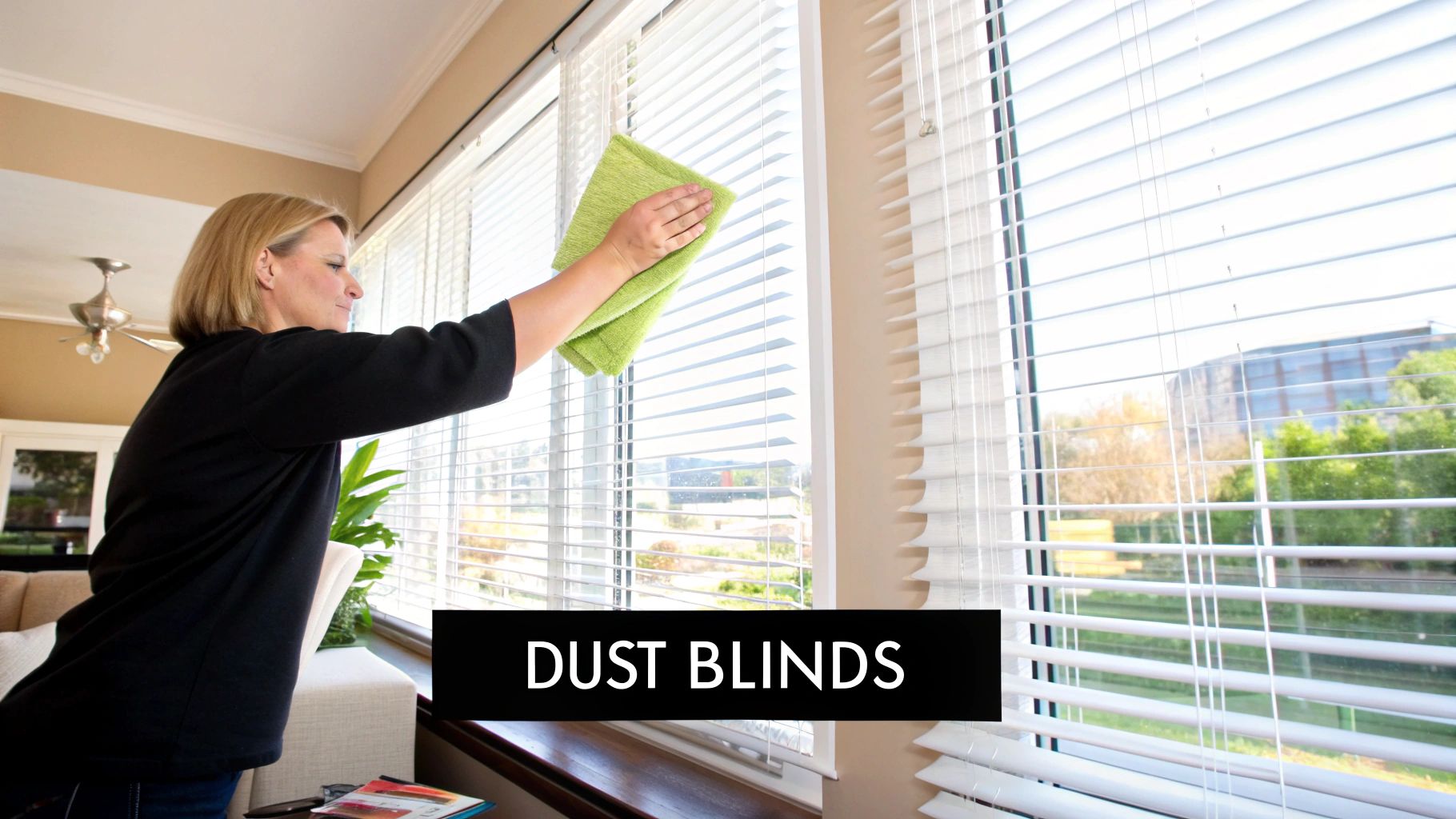
Alright, let's get our hands dirty. For those durable, water-safe blinds—I'm talking about vinyl, plastic, or aluminum—you've got more firepower when it comes to tackling serious grime. These materials can handle a proper wash, which is a lifesaver for blinds in places like the kitchen where grease and dust team up to create a sticky mess.
I'll walk you through two of my go-to methods. The first is a thorough wipe-down for moderately dirty blinds that you can do without even taking them down. The second is the full-immersion bathtub method—the ultimate solution for blinds that are truly caked in filth.
The In-Place Wipe Down Method
For blinds that aren't horribly soiled but need a bit more than a quick dusting, a targeted wipe-down is perfect. It's way less disruptive than taking them down completely and works great for regular maintenance cleaning every few months.
First things first, close the blinds so they create a mostly flat surface. Mix up a simple solution of warm water with just a few drops of mild dish soap. Grab a soft microfiber cloth, dip it into the soapy water, wring it out really well, and then wipe each slat from top to bottom.
Once you've done one side, flip the slats the other way and repeat the process. This little trick ensures you clean the entire surface area. After you’re done with the soap, follow up with a separate, clean cloth dampened with only water to rinse away any lingering residue.
The Full Bathtub Immersion Clean
When your blinds have graduated to a stubborn layer of grime, a deep clean in the bathtub is your best bet. I’ve found this method is incredibly effective for vinyl or aluminum blinds that have been neglected or are constantly exposed to kitchen grease.
Taking Down the Blinds
Carefully remove the blinds from their mounting brackets. Most have a simple clip or latch system that's easy to figure out. Just be gentle so you don't bend any slats or damage the headrail mechanism.
Prepping the Bath
Lay an old towel in the bottom of your bathtub. This simple step is a must to keep the blinds from scratching up the tub's surface. Now, fill the tub with a few inches of warm water—just enough to submerge the blinds—and add a squirt of mild dish soap. Swish it around to get some suds going.
The Soaking Process
Gently place the blinds in the soapy water, making sure they're fully submerged. Let them soak for about 30 minutes to an hour; this gives the soap time to work its magic and loosen all that caked-on dirt. For an extra-deep clean, you can gently agitate the water or use a soft sponge to wipe down the slats while they soak.
My personal trick is to slightly angle the blinds in the water. This allows the soapy water to flow between each slat more freely, ensuring a more even and thorough clean without you having to scrub every single one individually.
Rinsing Away the Grime
After a good soak, drain the dirty water. Use your shower head or a bucket of clean, cool water to rinse the blinds thoroughly. Don't skip this part—any leftover soap scum will just get sticky and attract even more dust later on.
If you live in an area with hard water, you know the struggle with mineral deposits leaving stubborn spots. For some great tips, check out our guide on how to remove hard water stains to help keep your blinds and other surfaces spotless.
Drying Your Blinds Perfectly
The final step—drying—is just as important as the washing. If you don't dry them properly, you'll end up with water spots, streaks, or even rust on the metal components. You've got a couple of solid options here:
- Air-Drying Outside: On a warm, dry day, hanging the blinds over a clothesline or railing outside is ideal. The fresh air and sunlight will get them dry quickly and naturally.
- Indoor Drying: If outdoor drying isn't an option, just hang the blinds over your shower curtain rod. Be sure to place a towel underneath to catch any drips. You can also gently pat them down with a dry microfiber towel to speed things along.
Make sure they are 100% dry before you rehang them. This prevents any mildew growth or mechanical issues down the road. It’s this kind of attention to detail that explains why professional blind cleaning has become such a booming industry. In fact, the market was valued at USD 1.2 billion in 2023 and is projected to hit USD 2.5 billion by 2033, all driven by a growing awareness of home hygiene. You can discover more insights about this growing market on DataHorizzon Research.
Safely Cleaning Wood and Fabric Blinds
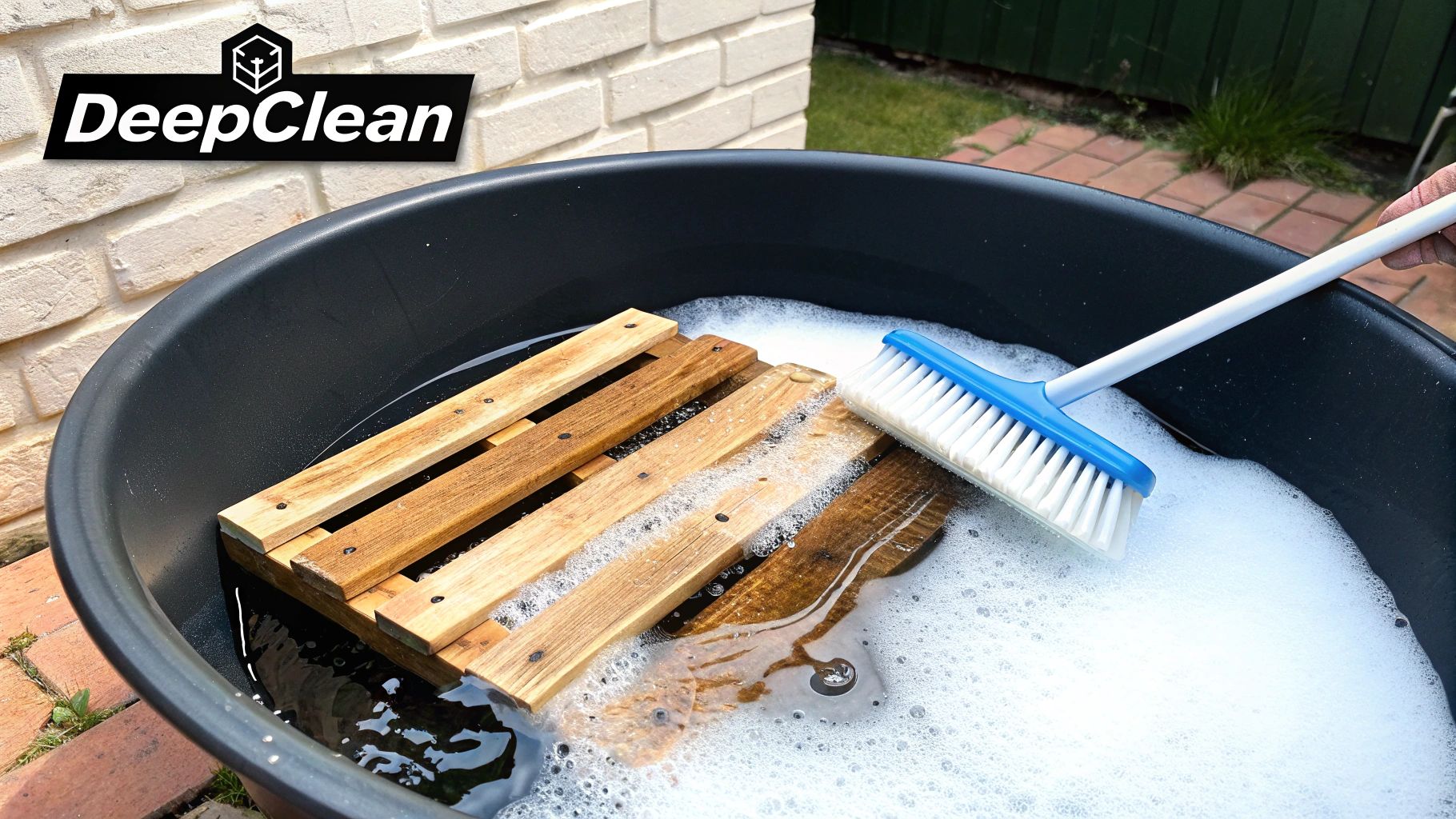
When you're dealing with delicate materials like wood or fabric, the aggressive deep-cleaning methods we've talked about are completely off the table. These blinds require a much gentler, more strategic approach. Water is the primary enemy here, capable of causing irreversible warping, discoloration, or shrinkage.
This means we need to shift our thinking from "washing" to careful, routine maintenance. The goal is to lift dust, treat minor stains, and preserve the material's integrity without a full water submersion. Think of it as specialized care for a premium feature in your home.
Caring for Wood and Faux Wood Blinds
Real wood blinds bring a certain warmth to a room that's hard to replicate, but they do demand specific care. Exposing them to excess moisture can cause the wood to swell, warp, or crack, completely ruining them. The secret is a mostly dry cleaning process.
Your best friend for this job is a high-quality microfiber cloth or duster. Just close the blinds and wipe each slat from one side to the other, working your way from top to bottom. Then, flip the slats and repeat on the other side to catch any remaining dust.
For a bit of extra shine and protection, you can use a wood conditioner or polish made for furniture. Apply a small amount to a clean, dry cloth and gently wipe down the slats. This not only cleans but also nourishes the wood and helps repel future dust.
Never spray cleaner or polish directly onto the blinds. This can lead to an uneven, oversaturated mess. Always apply the product to your cloth first, then wipe it onto the slats for controlled, even coverage.
Faux wood blinds are much more forgiving since they're made from moisture-resistant PVC or composite materials. While they can handle a slightly damp cloth for tougher smudges, you should still avoid soaking them. A quick wipe with a cloth lightly misted with water is usually all it takes.
Gently Cleaning Fabric Blinds and Shades
Fabric blinds—like cellular, Roman, or pleated shades—are basically magnets for dust and airborne particles. Your vacuum cleaner, fitted with its soft brush or upholstery attachment, is the single most important tool for keeping them clean.
Start by gently vacuuming the shades from top to bottom on low suction. This will lift most of the loose dust and debris without stretching or damaging the delicate fabric. If you have cellular shades, pay close attention to the inside of the cells where dust and even small insects love to hide.
Spot-Treating Stains on Fabric
When a spill happens, you have to act fast. Here’s how to tackle a stain without making it worse:
- Blot Immediately: Grab a clean, dry white cloth and gently blot the stain to absorb as much liquid as possible.
- Use a Mild Solution: Mix a few drops of mild dish soap into some lukewarm water.
- Dab, Don't Rub: Lightly dampen another clean cloth with the soapy solution and gently dab the stain, working from the outside in. Rubbing will only spread the stain and can damage the fabric fibers.
- Rinse and Dry: Use a third cloth dampened with plain water to blot the area and remove any soap residue. Then, let it air dry completely.
While our focus here is on blinds, many of these fabric care principles are universal. For more tips on fabric window treatments, you might find our comprehensive guide on washing curtains helpful.
When to Call a Professional Cleaner
Sometimes, a DIY approach just won't cut it. For deep-set stains, heavy soiling from years of neglect, or persistent odors from smoke or pets, calling a professional is the safest bet. They have specialized ultrasonic cleaning equipment that can restore your blinds without the risk of damage.
The demand for these services shows just how many homeowners prefer to trust delicate jobs to the experts. The global blind cleaning services market was valued at USD 4.5 billion in 2023 and is projected to hit USD 6.78 billion by 2032. This growth reflects a clear trend toward specialized, professional home care. You can explore more about this market's expansion on wiseguyreports.com.
Common Blind Cleaning Mistakes to Avoid
Knowing how to wash blinds properly is one thing, but knowing what not to do is just as important. Over the years, I've seen countless well-intentioned cleaning efforts go sideways, leading to discolored, warped, or just plain ruined blinds. Trust me, steering clear of a few common pitfalls will protect your investment and save you a massive headache.
One of the biggest culprits? Harsh chemicals. It’s so tempting to grab a powerful cleaner for tough grime, but products with bleach or ammonia are a disaster waiting to happen. They can turn plastic blinds yellow, strip the protective finish right off faux wood, and cause permanent discoloration on many materials.
Oversaturating with Water
Another critical mistake is going overboard with water, especially on the wrong type of blinds. While vinyl or aluminum blinds can handle a good soak, this is the fastest way to destroy other materials.
- Wood Blinds: Any excess water will make real wood swell, warp, and even crack. That kind of damage is irreversible.
- Fabric Shades: Soaking fabric blinds can leave behind ugly water stains, cause the material to shrink, and might even dissolve the adhesives holding them together.
Always remember that for wood and most fabric blinds, a "dry clean" approach is the only safe bet. A quick vacuum or a barely damp cloth is all you need.
A classic mistake I see all the time is people rushing the drying process. Rehanging blinds while they’re still damp is a recipe for disaster. It traps moisture between the slats and inside the headrail, creating the perfect breeding ground for mildew and rust, which can completely jam up the internal mechanisms.
Other Frequent Cleaning Errors
Beyond using the wrong liquids, a few other habits can cause unintended damage. For instance, people often scrub way too aggressively. Applying too much pressure, even with a soft sponge, can easily scratch finishes or bend those delicate aluminum slats out of shape. A gentle touch is always the better approach.
Similarly, forgetting to dust before washing is a rookie move. It just creates a muddy paste that gets smeared all over, making the job ten times harder. A quick once-over with a vacuum or microfiber cloth lifts that loose layer of grime first, letting your cleaning solution get right to the stubborn spots. Avoiding these simple missteps is the key to keeping your blinds looking great for years to come.
Frequently Asked Questions About Washing Blinds
Even with the best guide, there are always a few lingering questions. It's totally normal to get stuck on the little details, especially when you're trying to figure out how to wash your blinds correctly for the first time. I've gathered some of the most common questions I hear to give you direct answers so you can clean with confidence.
Think of this as your quick-reference cheat sheet for those "what if" moments. From how often you should clean to tackling those grubby cords, these are the practical tips that really make a difference.
How Often Should I Be Washing My Blinds?
For regular maintenance, a light dusting every week or two is all you need to prevent heavy buildup. This simple habit keeps dust and allergens down and makes the bigger cleaning jobs way easier.
A full, deep wash like the methods we’ve gone over is usually only needed once or twice a year.
Of course, your home’s environment matters. If you have pets, family members with allergies, or live in a dusty area, you might want to deep clean seasonally. And kitchen blinds? They're a whole different story—they often need more frequent spot-cleaning to deal with grease and food splatters.
Can I Use a Pressure Washer on Outdoor Blinds?
I get this question a lot, and my answer is always a firm no. Please don't do this.
Even on the lowest setting, a pressure washer is just too powerful for most blinds. The intense spray can easily bend aluminum slats, strip the finish right off, and snap the delicate cords or internal tilting mechanisms. It's a costly mistake waiting to happen.
The much safer route for outdoor blinds is a garden hose on a gentle setting, a soft-bristled brush, and a bucket of mild soapy water. You'll have complete control without risking any damage.
Is It Safe to Put Fabric Blinds in the Washing Machine?
Absolutely not. Putting fabric blinds in a washing machine is a recipe for disaster. The aggressive spinning and tumbling will almost certainly ruin them.
You can expect them to shrink, fray, or lose their shape entirely. Plus, the adhesives and structural bits that give them their form can dissolve, leaving you with a limp, useless mess.
For any type of fabric shade, always stick to one of these three methods:
- Gentle vacuuming using a soft brush attachment.
- Spot-cleaning stains carefully with a mild cleaning solution.
- Calling a professional for a deep clean that won't destroy them.
What Is the Best Way to Clean Dirty Blind Cords?
It’s amazing how much grime builds up on the cords and wands from just our hands. The easiest way to clean them is to grab a microfiber cloth and dampen it with a simple soap and water mix.
Pinch the cord inside the cloth and just slide it down the entire length. Repeat it a few times until it comes away clean. If you've got stubborn dirt on braided cords, a soft toothbrush can work wonders—just scrub gently so you don't fray the material.
Feeling like deep cleaning your blinds is a bit much to take on? Let the experts at Custom Maids handle it for you. We provide meticulous, professional cleaning services to keep your home looking its best. Get your free consultation today!

